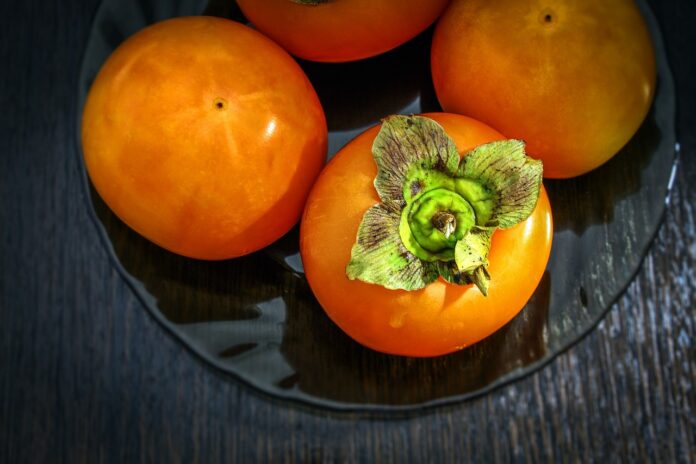Persimmons are vibrant orange, smooth-skinned fruits that originate from various species of the Diospyros tree. They are known for their unique, honey-like flavor, which ranges from sweet and rich to slightly tangy, depending on their level of ripeness.
Persimmons are most commonly divided into two main types: astringent and non-astringent. Astringent varieties, like Hachiya, are high in tannins and must be fully ripe and soft to be eaten, while non-astringent varieties, such as Fuyu, can be consumed when they are still firm.
Interesting Facts About Persimmons:
- Ancient Origins: Persimmons have a long history, first being cultivated in China over 2,000 years ago. They hold a significant place in Chinese medicine and cuisine, believed to offer various health benefits such as improving digestion and reducing inflammation. From China, persimmons spread to Japan and Korea, where they became essential to the local diet and culture
- National Fruit of Japan: The kaki persimmon (Diospyros kaki) is celebrated in Japan and symbolizes autumn. Festivals dedicated to persimmons are common, and the fruit is used in traditional Japanese dishes like hoshigaki (dried persimmons). Kaki persimmons are also popular in gardens, and the trees are admired for their ornamental beauty during the fall
- China leads by a massive margin, producing more than 70% of the world’s persimmons. In the United States, California is the top producer, primarily of the Asian persimmon variety.
- Tannins and Ripeness: Tannins, which are polyphenolic compounds, are highly concentrated in unripe persimmons, causing a mouth-puckering astringency. As the fruit ripens, the tannins break down, resulting in a sweet, luscious flavor. This transformation is particularly notable in Hachiya persimmons, which are inedible when firm but delectable when fully ripe
- Different Varieties: There are over 2,000 varieties of persimmons globally, but Hachiya and Fuyu are the most widely known. Hachiya persimmons are heart-shaped and must be soft before consumption, while Fuyu persimmons are round, tomato-like, and can be eaten firm or soft. This versatility makes Fuyu a preferred variety in salads and desserts
- ‘Chocolate Persimmon’: The ‘chocolate persimmon,’ or Diospyros kaki var. chocolate, gets its name from the dark, cocoa-colored flesh. When ripe, it has a sweet, caramel-like flavor, often described as having hints of chocolate, making it a coveted variety for enthusiasts and a highlight at specialty fruit markets in Japan and the United States
- Botanical Classification: Botanically, persimmons are classified as berries, despite their size and fleshiness. This classification is due to the development of the fruit from a single ovary and the presence of seeds embedded in the fleshy interior. This makes them similar to fruits like grapes and tomatoes, which are also true berries
- American Persimmons: The American persimmon (Diospyros virginiana), known as the ‘possum apple,’ has been native to the southeastern United States since the Pleistocene era. Indigenous peoples and early settlers used the fruit in traditional recipes like persimmon pudding and bread. The species still thrives in forests, often visited by wildlife that spreads its seeds
- Pleistocene Legacy: The American persimmon co-evolved with large herbivores like mastodons and giant ground sloths. The fruit’s size and hard seeds suggest it was adapted for dispersal by these now-extinct megafauna. Today, persimmon seeds germinate better after passing through an animal’s digestive tract, mimicking this ancient relationship
- Civil War Uses: During the American Civil War, persimmon seeds were roasted and ground as a coffee substitute when real coffee was scarce. Additionally, the hard seeds were used to make buttons for soldiers’ uniforms, reflecting the resourcefulness of people during wartime
- Weather Folklore: The Ozarks region holds a unique folklore tradition involving persimmon seeds: slicing a seed open reveals a white shape inside. If it resembles a spoon, it means a snowy winter; a fork suggests mild weather, and a knife predicts bitter, cutting cold. This rural weather prediction method remains a charming part of local culture
- True Ebony: Persimmon wood, especially from the American persimmon tree, is prized for its strength and density. The heartwood is a true ebony, extremely hard and used historically for making golf club heads, pool cues, and high-quality musical instruments
- Over 700 Species: The Diospyros genus comprises over 700 species, with many prized for their timber rather than their fruit. The most famous timber species is the ebony tree, whose jet-black wood is sought after for furniture, carvings, and fine arts
- Tastes of ‘Chocolate Pudding’: The Diospyros nigra, known as the black sapote or ‘chocolate pudding fruit,’ grows in Mexico and Central America. Its ripe fruit has a creamy, dark brown pulp with a flavor reminiscent of chocolate pudding, making it a unique tropical delicacy
- Middle Eastern History: During Roman times, persimmon trees from the Middle East were sources of valuable products like incense, poultices, and oil. These trees were significant in ancient trade and medicine, used to treat ailments and create perfumed oils
- Wildlife Attraction: Persimmon oil is used as bait in hunting and wildlife observation because its strong aroma is irresistible to animals. From deer and raccoons to wild turkeys, the scent of persimmon attracts a wide array of wildlife, aiding both hunters and conservationists
- Natural Dye: The Japanese dye Kakishibu, made from fermented unripe persimmons, is used in traditional textiles, paper, and even as a wood preservative. The dye has antimicrobial properties and has been utilized in Japan for over 1,000 years
- Unique Germination: Persimmon seeds germinate best after being acid-scarified, a process that simulates their journey through an animal’s digestive system. This natural adaptation ensures better seedling survival and has been observed in ecological studies on seed dispersal
- Seasonal Connection: In areas like Ruffner Mountain, Alabama, persimmons are a beloved autumnal feature. They are seen as a harbinger of the season, falling from trees and creating a burst of orange along trails, attracting people and wildlife alike to enjoy the bounty
